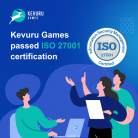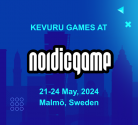3D modeling is an integral part of game development that brings the game to life with realistic graphics and animations. Let’s start with understanding the basis of 3D modeling, differentiating it from rendering, and then exploring various types of 3D modeling used in modern games. We will also take you through the step-by-step process of creating a 3D game modeling. Lastly, we will discuss how 3D modeling studios impact the creation of games and why it is crucial for immersive game design.
The Foundation of 3D Modeling
3D modeling plays a crucial role in developing video games, as it involves the creation of virtual representations of objects and characters in the game world. This process includes creating wireframe models, texture mapping, and geometry optimization to ensure seamless integration into game engines. Over time, 3D modeling technology has evolved, providing game designers with the precision and intricate detail required to model characters enhancing the game’s visual appeal.
In addition, the process of 3D modeling includes vertex mapping, rigging, and animation, which requires a deep understanding of mesh optimization to achieve the desired results. Understanding the foundational principles of 3D modeling is essential to game design as it contributes to player immersion and creates a visually engaging game world. By understanding these principles, game designers can create an immersive gaming experience that engages the audience and makes 3D modeling an integral aspect of modern video game development.
The Importance of Understanding 3D Modeling vs. Rendering In Game Development
The process of 3D modeling includes creating wireframe models, texture mapping and geometry optimization to ensure seamless integration into game engines. Over time, 3D modeling technology has evolved to provide game designers with the detail required for character modeling, increasing the visual appeal of the game.
In addition, 3D modeling includes mapping, rigging, and animation, which requires a deep understanding of mesh optimization to achieve the desired results.
In game development, it is important to distinguish between 3D modeling and rendering. 3D modeling game is about creating the actual 3D model and defining its structure while rendering focuses on creating the final 2D image or animation.
This distinction illustrates the role of modeling and rendering in bringing virtual worlds to life in video games. Modeling involves the development of polygon meshes, character models, and prop designs and focuses on the construction of game content. Rendering, on the other hand, deals with lighting, texturing, and the integration of photorealistic details to improve the visual fidelity of the game environment.
Types of 3D Modeling and Services for Games That Can Be Outsourced By Game Developers
3D character modeling is a cornerstone of modern games, involving creating game characters, non-playable characters (NPCs), and game-world assets. Detailed 3D models, such as vehicles and weapons, demand poly-count optimization and mesh rigging to bring them to life within the game environment. Moreover, game development often requires single asset modeling, where a single model is utilized for various game scenarios, optimizing resources.
Integrating 3D modeling technology in game design contributes to creating online games, virtual reality (VR), and augmented reality (AR) experiences, captivating players worldwide.
3D Character Modeling for Modern Games
3D character modeling for modern games involves the creation of game personas with a focus on polygon count, rigging, and animation. Utilizing game design software like Maya, Blender, and 3Ds Max enables precise character modeling for immersive gaming experiences. The process integrates animation, prop design, mesh optimization, and UV mapping to deliver engaging game characters, capturing fine details, human body proportions, and facial expressions essential for modern games. As a fundamental aspect of game development, character modeling contributes to the overall design by transforming game characters into central game elements and enhancing the gaming experience.
As an example, the Kevuru Games team creates the most lifelike characters for every scene, using skills and tools to enhance the characters’ details and give the impression that they are actual humans or animals. The stylistic methods Kevuru’s artists use are determined by the specifics of the project and the type of game. The customer may need to make 3D characters in various styles, from comic realism to cartoonishness. It’s important to work over clothes and skins.
Modeling and texturing of 3D environments in games
There are two primary types of modeling: architectural modeling for buildings and structures, and organic modeling for natural elements like landscapes and characters. Architects of virtual realms use tools like Blender, Maya, or 3ds Max to mold their ideas into tangible forms. Creating immersive 3D game environments involves meticulous modeling and texturing to breathe life into virtual worlds. This dynamic duo forms the backbone of a game’s visual appeal, influencing player engagement and overall gaming experience.
Any outsourcing team of experts should be professional in 3D environment design. It’s vital to have skills and expertise to create an outdoor and indoor 3D environment design. Like these scenes can be streets, forests, buildings, rooms or something else that can be used in a 3D game environment.
Creation of detailed 3D models of vehicles in games
Crafting detailed 3D models of vehicles involves capturing every nuance, from the gleam of the headlights to the wear and tear on the tires. The goal is to make players feel the adrenaline, to make the virtual ride as exhilarating as the real thing. Driving simulators have become much more popular in recent years due to the advancement of computer and console games. Players of many ages and interests have formed enduring memories with the immensely popular NFS, making it valued.
As gaming technology capabilities increased, so did the level of detail in locations and game elements such as vehicles. It could be difficult to distinguish a real photo from a current AAA automobile simulator rendering these days.
In video games, cars frequently function as either weapons or modes of mobility. Players’ comprehension of these vehicles’ practical utility and functionality is improved by the meticulous creation of their 3D models. This is crucial for military simulations and other games where the gameplay revolves around vehicles.
Creation of 3D models of weapons in games
In a game production studio, the Weapon Department is typically made up of 3D artists. They get thoughts, references, and technical details from art directors and concept artists in related fields. Since the idea of a weapon requires a great deal of talent, the team can decide how complex the idea should be by utilizing the technical data provided by the customer.
The RPG weapons concept calls for a wide range of skills as well as an understanding of the mechanics, including how this kind of weapon operates and determining the appropriate level of sophistication based on the technical documents provided by the client. The concept artists need to implement all ideas accurately. It’s convenient when the outsourced team offers a full weapon creation cycle, from concept to 2D and 3D graphics to models and animation for game development.
In many games, including role-playing games and first-person shooters, weapons are essential. Consequently, producing incredibly realistic 3D weapon models is essential to provide an engaging game environment. Weapon handling precision and speed are critical in first-person shooter games. Players are able to aim and fire their weapons with accuracy and speed thanks to a well detailed 3D model.
3D modeling of game props
Depending on the genre and game, there may be differences in the pipeline for creating props, usually it’s better to use hybrid approaches. For PC and console games, the algorythm of game development process can look somewhat like this:
Step I. Prepare 3D model blocking (silhouette and basic shape);
Step II. Creation of high-poly model;
Step III. Model optimization or low-poly generation.
Step IV. UV synthesis, the 3D model being scanned;
Step V. Baking or roasting;
Step VI. Texturing of models, painting, and material generation processes.
A well-crafted prop—whether it’s a streetlight, a piece of furniture, or a plant—adds to the game’s overall mood and gives the virtual world life. By employing 3D modeling techniques for gaming assets, artists elevate the game environment and give it a more vibrant, genuine, and dynamic appearance.
3D Modeling For Virtual Reality Games
In VR, the player isn’t merely peering into a world through a screen; they’re literaly, stepping into it. This demands a shift in perspective for 3D modelers. Environments must not only be visually stunning but also spatially coherent.
The hardware is tasked with rendering two screens simultaneously, one for each eye, at a high frame rate to prevent motion sickness. This means 3D models must be optimized for efficiency without sacrificing visual fidelity. Smartly constructed models with efficient polygon usage become the characters, ensuring a seamless VR experience.
In the VR realm, players can physically reach out, grab, and manipulate objects. This dynamic requires 3D modelers to consider not just the visual appeal of an object but also its physicality. A well-designed VR model isn’t just seen; it’s touched, interacted with, and responds realistically to user actions, enhancing the sense of presence. 3D modelers also need to pay meticulous attention to scale, ensuring that every element fits harmoniously into the VR environment.
3D Model Creation for Games: Step-by-Step Process
The process of 3D character modeling for video games involves several stages, each with its own unique challenges. Here are the steps typically involved in 3D model creation:
| Conceptualization | This is the first stage of the process where ideas and concepts are brainstormed, and sketches or concept art may be created. |
| Modeling | The actual creation of the 3D model using specialized software such as Maya, Blender, or 3ds Max. |
| Detailing | Adding intricate details to the 3D model to make it more realistic and visually appealing. |
| UP Mapping | The process of unwrapping the 3D model’s surface to apply textures accurately. |
| Texturing | Adding color, texture, and materials to the 3D model to make it appear more lifelike. |
| Rigging | The process of creating a skeleton for the 3D model which allows for animation and movement. |
| Animation | Bringing the 3D model to life by adding movement and expressions through keyframes or motion capture. |
| Optimization | Reducing the number of polygons in the 3D model to improve its performance in a game engine. |
| Integration | The process of importing the 3D model into the game engine and making any necessary adjustments for it to function correctly. |
| Testing and Iteration | Thoroughly testing the 3D model in-game and making any necessary changes or improvements. |
Outsourcing in the Gaming Industry
Outsourcing 3D modeling tasks to creative studios can provide significant advantages for game developers, including:
- Cost Savings: Hiring an external team can be more cost-effective than having an in-house 3D modeling team.
- Increased Efficiency: Outsourcing allows game developers to focus on other aspects of game creation while experts are creating the 3D models.
- Access to Advanced Technology: Most outsourcing companies have access to the latest software and technology, which can result in higher quality and more advanced 3D models.
- Access to Expertise: By outsourcing, game developers can access a pool of talented and experienced 3D modelers who specialize in different areas such as character modeling, environment modeling, or prop modeling.
- Faster Delivery: Outsourcing companies usually have more resources and can complete tasks faster than an in-house team, allowing quicker turnaround times.
Tips for Utilizing 3D Modeling in the Gaming Industry
Before diving into 3D modeling, have a crystal-clear understanding of your game’s requirements. Different genres and gameplay styles demand specific approaches to 3D modeling. Whether it’s a first-person shooter or an open-world adventure, tailor your modeling techniques to suit the game’s essence.
Invest in Quality Software
The right tools make all the difference. Invest in high-quality 3D modeling software that aligns with your project’s needs. From industry standards like Blender and Maya to specialized tools, choose software that enhances efficiency and creativity.
Prioritize Realism When Necessary
If realism is the goal, pay meticulous attention to details. Realistic character models, environments, and textures contribute to an immersive gaming experience. Leverage the capabilities of your chosen 3D modeling software to achieve lifelike visuals.
Stay Updated on Industry Trends
The gaming industry is ever-evolving, and so is 3D modeling technology. Stay updated on the latest trends and advancements. Embrace new techniques, tools, and trends to keep your game development at the forefront of innovation.
Explore Procedural Generation Techniques
Procedural generation can significantly streamline certain aspects of 3D modeling. Explore techniques that allow you to generate textures, landscapes, or even character variations procedurally. It not only saves time but adds a layer of uniqueness to your game.
Test Models in Different Environments
When creating, test your 3D models in various gaming environments. Understand how lighting, textures, and models interact in different scenarios. This iterative process ensures that your models will stand out in any gaming setting.
Consider Modular Design for Assets
Modular design simplifies the game development process. Create reusable 3D assets that can be combined and adapted for different purposes. This not only saves time but also maintains a consistent visual style throughout your game.
Utilize 3D Modeling in Marketing Materials
Extend the use of your 3D models beyond the game itself. Incorporate them into marketing materials, trailers, and promotional content. Stunning visuals in marketing materials can generate excitement and anticipation among potential players.
Experiment with Animation Techniques
Dynamic and expressive animations breathe life into your game. Experiment with different animation techniques to convey emotions, actions, and reactions effectively. Well-animated characters and objects contribute to a memorable gaming experience.
Opt for Rigging for Articulation
Rigging adds articulation to your 3D models, allowing for realistic movements. Whether it’s characters, creatures, or machinery, proper rigging enhances the visual narrative of your game. Invest time in mastering rigging techniques to elevate the overall quality of your models.
Embrace User-Generated Content (UGC)
Empower your gaming community by allowing user-generated content. Create tools that enable players to modify or create their own 3D models. This not only adds a layer of personalization but also extends the longevity of your game.
Encourage Feedback from the Gaming Community
It’s actually the right move seeking feedback from the gaming community. Whether through beta testing or social media engagement, understand how players respond to your 3D models. Valuable insights from the community can guide refinements and improvements.
The Future of 3D Modeling in Gaming Industry
The demand for high-quality and realistic games continues to grow, which means the need for efficient and advanced 3D modeling techniques will also increase.
With the rise of virtual reality and augmented reality technologies, 3D modeling will become even more vital in the gaming industry. These technologies require detailed and realistic 3D models to provide an immersive experience for players.
Moreover, as technology continues to advance, we can expect to see new software and tools that will make 3D modeling even more efficient and accessible for game developers.
As we continue to see advancements in technology, the future of 3D modeling in the gaming industry looks promising, and it will remain a vital aspect of game development.
Kevuru Games Expertise in 3D Modeling for Video Games
As a game art studio, Kevuru Games provides a variety of 3D modeling and game services that can be customized to meet the unique requirements of any project. Character, environment, prop, texturing, shading, and animation modeling are just a few of the 3D modeling and game services that we excel at. A cost-effective way to add top-notch 3D modeling and game design to your project is to outsource these services.
Kevuru team has over a hundred projects in its portfolio and produced 3D graphics for a wide range of customers, such as Lucasfilm, Epic Games, EA, GoodGame, Socialpoint, Nanobit, and others. The full-cycle game creation offered by the studio gives an advantage over numerous rivals.










